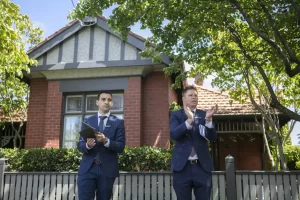Owner-occupiers and first home buyers returned to the home loan market in November even as banks started raising fixed rates, pushing up new mortgage commitments at their fastest rate in almost a year.
New home loans jumped 6.3 per cent – their highest growth rate since January – for a total of $31.4 billion in the same month that credit costs started rising and the Australian Prudential Regulation Authority lifted the serviceability buffer requirements for lenders.
The first increase in four months of owner-occupiers and the first in six months of first-time buyers went against expectations, CBA economist Kristina Clifton said.
“This was surprising given that some of the major lenders have been increasing fixed lending rates in recent months,” Ms Clifton said.
“APRA’s increase in the serviceability buffer also came into place at the start of November, which reduces the average loan size at the margin, all else being equal.”
The overall increase was boosted by the 13th straight monthly gain in lending to investor borrowers, whose new loan commitments picked up 3.8 per cent to $10.1 billion – the highest monthly total in the Australian Bureau of Statistics’ records stretching back almost 20 years.
Owner-occupier loans jumped 7.6 per cent and first home buyer loans were up 3.7 per cent from October.
Affordability still a ‘key issue’
Average loan sizes reached new highs in all states and territories except Western Australia, which the Real Estate Institute of Australia said pointed to further affordability problems.
“The average loan size for owner-occupier dwellings – which includes construction and new and existing dwellings – rose to an all-time high of $596,000,” Real Estate Institute of Australia president Hayden Groves said.
“This indicates that housing affordability in some regions could still be a key issue facing Australians.”
CommSec senior economist Ryan Felsman said the “modest” increase in loans to that segment showed they were struggling as a cohort.
“First home buyers are being squeezed out of the housing market,” he said.
November’s figures – in a month in which Sydney’s median home price rose $12,000 and Melbourne’s gained $5835 – go some way to reversing a reduction in lending from mid-year resulting from lockdowns in Victoria and NSW, but they do little to dispel expectations of further regulatory curbs, JPMorgan economist Tom Kennedy said.
“Today’s print unwinds much of the recent weakness, though, in level terms, total loan values are still 3 per cent below May’s pre-lockdown peak,” Mr Kennedy said after the figures.
“We continue to expect additional macro-prudential measures to be implemented over time, which, alongside our forecast for the RBA (Reserve Bank of Australia) to lift the cash rate later this year (in the December quarter 2022), suggests the monthly pace of home lending is likely to slow.”
But curbs on consumer behaviour resulting from the omicron wave – whether formal lockdowns or a loss of confidence among people themselves – could dampen activity and demand for credit, BIS Oxford Economics economist Maree Kilroy said.
“The current omicron variant surge is expected to have a dampening effect on residential property transactions over Q1 2022, with the elevated risk of infection seeing households behaving more cautiously and limiting movement,” Ms Kilroy said.
Omicron could “potentially” dampen activity to the extent that further macro-prudential measures were needed, however, APRA was consulting on the issue in a process that would go until the end of March and the current wave of omicron may well have passed by then, she said.
This article is from Australian Financial Review, please click the following link for the original article: https://www.afr.com/property/residential/home-loans-bounce-back-even-as-fixed-rates-rise-20220114-p59o7d




